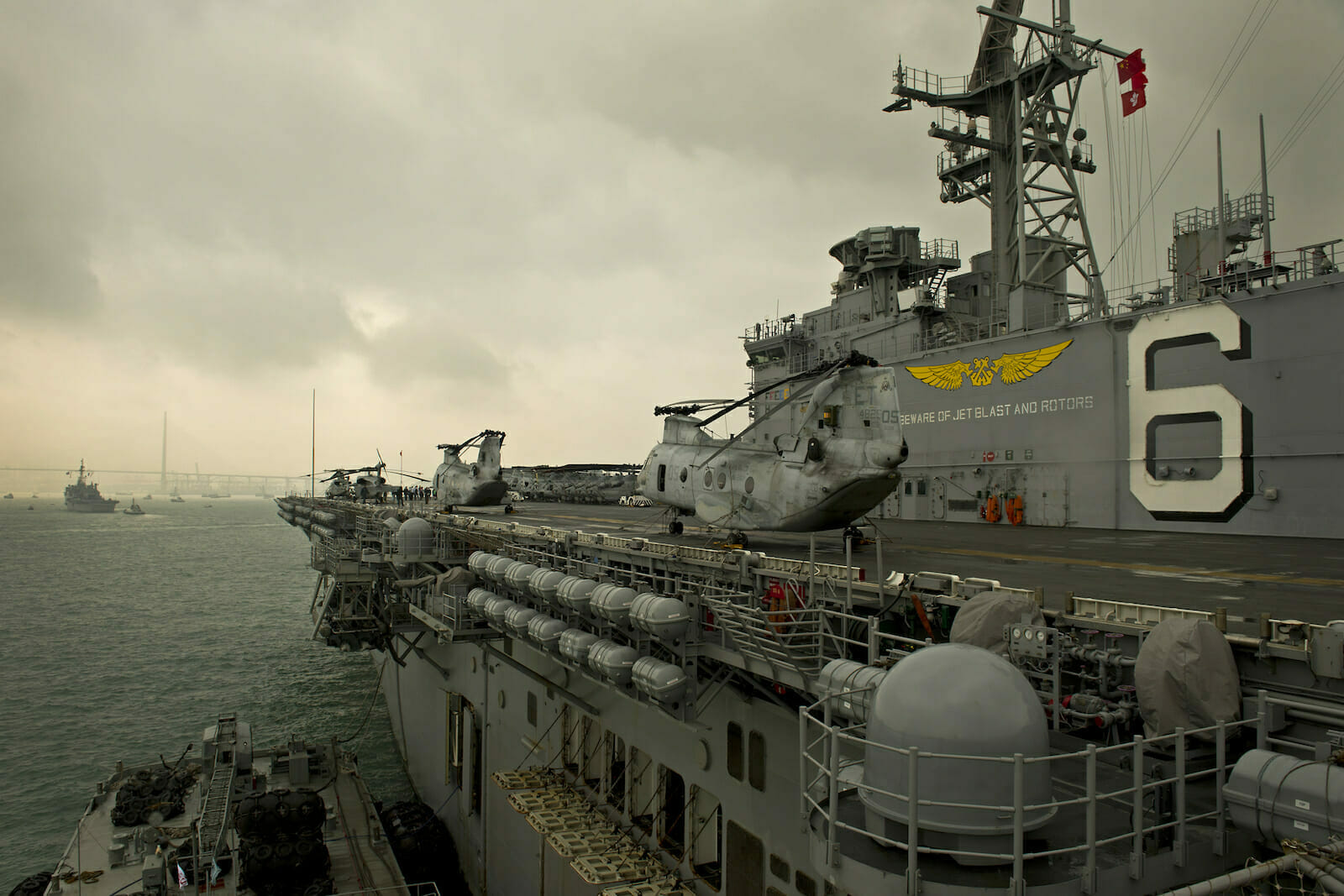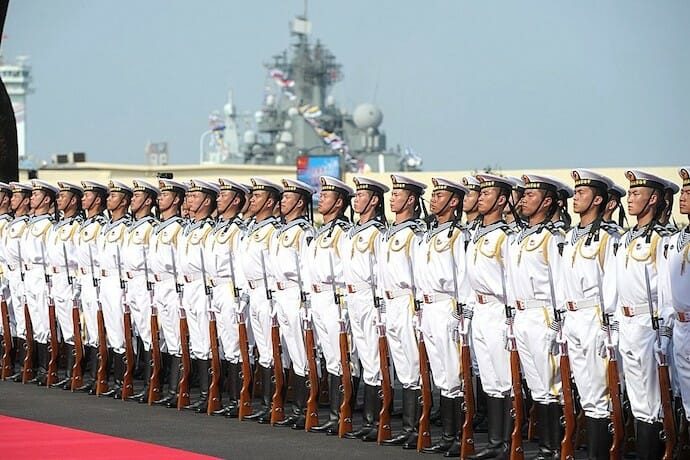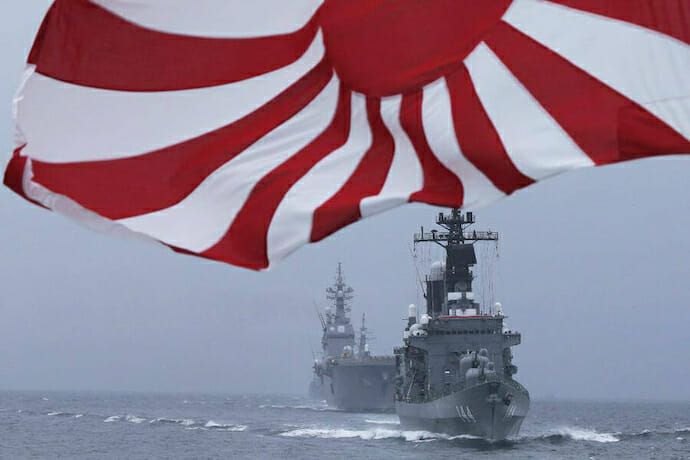
Lend-Lease and Chinese Containment
Thirty years after the fall of the Berlin Wall and the end of the Cold War, the United States finds itself becoming embroiled in another confrontation with a new expansionist power, a rising China. China has become a threat not only to world peace but an end to the freedom of billions of people living in and around South East Asia. With the United States struggling to counter threats from a revisionist Russia, its continuing struggle to contain fallout from its misadventures in the Middle East, and sharp disagreements with its traditional allies, the United States military finds itself spread thin around the globe.
With such heavy demands upon the U.S. military, a new strategy needs to be implemented where the threatened nations in the Indo-Pacific region have the tools necessary to counter the rising power of the Chinese PLAN, but in a way which would not push the region into open conflict.
HR 1776: An Act to Promote the Defense of the United States
During the early stages of World War Two, Franklin Roosevelt, then president of the United States, came up with the idea of helping those nations fighting against Nazi aggression and a Germany bent on dominating the European-Asian continent. Unable to openly fight on the side of the West due to the strong isolationist sentiment in the United States at the time, he came up with the idea of Lend-Lease.
President Roosevelt proposed augmenting the military forces of the United Kingdom by lending them the military arms and munitions that they needed to protect themselves from Nazi tyranny. When Hitler invaded the then Soviet Union in 1941, Russia also began receiving Lend-Lease supplies and equipment. At the end of the conflict, these arms and munitions that had not been expended would be returned to the U.S. During World War Two, some $50.1 billion (in today’s dollars that would be $697 billion) was dispensed by Lend-Lease to its allies. The most important recipient of Lend-Lease was Russia as without Lend-Lease, the then Soviet Union would not have been able to fend off Germany.
A Modified Lend-Lease Program for Asia
Today, instead of Nazi tyranny, it is the tyranny of China and its predatory behavior that is threatening world peace and the freedom of democracies worldwide. Instead of the all-out support that the U.S. provided its allies during World War Two, a more modified and limited form of Lend-Lease would be appropriate in responding to the threats posed by China.
The best assistance that the United States can give to its friends and allies in Asia at this point in time is by providing the naval military equipment it currently holds in its Mothball Fleet and providing military vehicles and weapon systems it holds in great quantities in its reserve arms depots in Northern California.
Since the circumstances surrounding today’s environment differ a great deal from the 1940s when Lend-Lease was originally designed, the provisions of any Lend-Lease activities today should be carefully mapped out in close consultations with the intended recipients of the aid given. It must be kept in mind that many of these countries have strong industrial bases, and the aid given should be of a temporary nature and the military hardware returned once their industrial bases have been able to ramp up and provide the military forces needed to deter future Chinese aggression.

Dr. Koh Swee Lean Collins, a noted scholar and research fellow at the S. Rajaratnam School of International Studies, noted that some of the countries that would be offered the surplus military equipment from the United States have domestic industries that might object to their country receiving surplus military equipment from the U.S., since it would decrease demand of this type of equipment that domestic companies would typically receive contracts for. Dr. Collins also observed that the aid would have to be tailored to the specific needs of each country and that a one size fits all mentality should be avoided at all costs.
Indonesia
Indonesia would have no need for a Tarawa-class amphibious escort carrier as it is an island archipelago nation. With islands dispersed in the Natuna and North Natuna Sea, land-based aircraft would provide a much better solution to their security needs than a Landing Helicopter Assault (LHA) vessel converted to a mini strike aircraft carrier. Several Perry-class frigates, on the other hand, would work well for the security needs of its naval forces. With a GDP of over $1 trillion, Indonesia would be able to support several of the Perry-class frigates if it so desired. While the U.S. would rehabilitate and restore the Perry-class frigates for use, it would be up to Indonesia to bear the operational costs of the frigates and provide for their upkeep and maintenance.
Japan
Japan currently has two de facto aircraft carriers currently on the active list. The Izumo-class carriers were originally classified as helicopter destroyers, their designation was changed to multi-purpose operation destroyer after it was announced that the Japanese Navy would be basing the F-35 Lightning on the two ships. Both the Izumo and the Kaga will be able to carry 12 F-35 Lightnings apiece. While Japan also operates two helicopter carriers of the Hyuga-class, they are not capable of VTOL aircraft operations. While measurably improving the striking power of the Japanese Navy, it does not begin to match the capability of the Chinese aircraft carriers currently being constructed by China.
Two of the Tarawa-class LHAs, converted to lightning carriers, would be of value to Japan’s naval forces and provide the Japanese Navy with extra hitting power. The Tarawa-class mini carriers would need escort vessels, so 4 to 6 Perry-class frigates would need to accompany the two Tarawa-class vessels. Japan’s GDP for the fiscal year 2018 was $4.9 trillion. With the economic strength of Japan much greater than Indonesia, it would be politically necessary for Japan to fund the restoration of the Tarawa carriers and any Perry frigates that would accompany the carriers in any Lend-Lease agreement.
With China becoming ever more aggressive in intruding on the Exclusive Economic Zone of Japan, and the length of time it takes for Japan to send aerial assets to the Senkaku Islands during incursions by Chinese fishing vessels and combat vessels from the Chinese PLAN, a mini carrier strike group (CSG) would prove to be a strong deterrent.

Japan has a more unique security problem than other nations in Asia. Besides having to defend itself from China, Japan must also face a threat to its northern border regions from Russia. Russia, at odds with the West over Crimea, has forged a tactical military alliance with China. In July of 2019, Russia and China conducted a joint bomber patrol with three Russian bombers and two Chinese bombers. Japan and South Korea both launched jet fighters to intercept the bomber force, and South Korea fired hundreds of warning shots against the bombers.
Because of the unique security challenges Japan faces, the U.S. should revisit its long-standing prohibition of providing F-22s to Japan. Both Japan and the U.S. should explore ways for the Japanese to have access to the world’s best fighter aircraft, and to protect the advanced technology that the F-22 possesses.
India
The Indian Navy only has one operational aircraft carrier, the INS Vikramaditya. The Vikramaditya is a Russian made Kiev-class carrier purchased from Russia in 2004. However, the Vikramaditya was not officially accessed into the Indian Navy until June of 2014.
Currently under production is the INS Vikrant which has been plagued by cost overruns and by construction difficulties. Originally scheduled for launch in 2010, the carrier, which is not expected to be commissioned until 2023, was launched in 2013. India has also begun construction on its third aircraft carrier, the Vishal, which is not expected to be available for active service until the 2030s.
The Vishal will be the first aircraft carrier not to employ a ski jump to assist in the launching of its aircraft. Instead, it is planned to employ the Electromagnetic Aircraft Launch System (EMALS).
India’s strategic naval objective is to have three operating carrier strike groups (CSGs) operational so as to have two CSGs on station at all times. With the INS Vikramaditya’s hull currently 32 years old, by the time the Vishal is commissioned, the Vikramaditya will be over 45 years old and would be no match for the aircraft carriers that China is currently constructing.
To bridge the gap between the time India is able to bring 3 modern aircraft carriers online, the U.S. could use a new Lend-Lease Act to give either the USS Kitty Hawk and/or the USS John F. Kennedy to the Indian Navy. If a Tarawa-class amphibious escort carrier is available, it also should be considered as a part of any Lend-Lease ship transfer.
To assist in the escorting of these assets being given to the Indian Navy, 2 to 4 Perry-class destroyers should also accompany the aircraft carrier(s).
India’s GDP in 2018 was $2.7 trillion. Because of the importance a strong Indian Navy is to the U.S., if a Lend-Lease program is authorized, the U.S. should bear the cost of refitting the Lend-Lease ships but leave the cost of maintaining and operating the Lend-Lease ships to the Indian government.
The Depletion of the U.S. Navy Reserve Fleet
The purpose of the U.S. Navy Reserve Fleet is to keep deactivated former U.S. naval vessels afloat and in sufficient condition to be reactivated in the case of a national emergency. The Reserve Fleet is also called the Mothball Fleet within the Navy.
This article has proposed depleting the Reserve Fleet of all its remaining Perry-class frigates, all of its remaining Tarawa LHA ships and at least one of its mothballed aircraft carriers.
This would not be possible unless the U.S. Navy had already decided that bringing these reserve vessels back into active service with the current U.S. Fleet would not be in the best interests of the U.S. Navy’s current program of adding much newer vessels to the Navy’s goal of achieving a 355 ship combat Navy.
It is important to note that any Lend-Lease program affected by the United States should be separately funded from the ongoing effort to bring the 355-combat vessel fleet into being.
While expensive, the proposed Lend-Lease program is a much more inexpensive and faster way to deter Chinese ambitions of military intimidation. History shows us that when the Chinese culture is faced with stiff odds of victory, it has always retreated strategically and waited for a more opportune moment.
The Lend-Lease program proposed in this article presupposes that eventually the current authoritarian government in China will encounter resistance to its heavy-handed treatment of its own citizens. It also presupposes, given the affinity the majority of the Chinese have for Western culture, that eventually a more representative form of government will arise in China.
It is then, and only then, that China will be able to fulfill its destiny, and join the world in search of a better and more stable world political environment.

